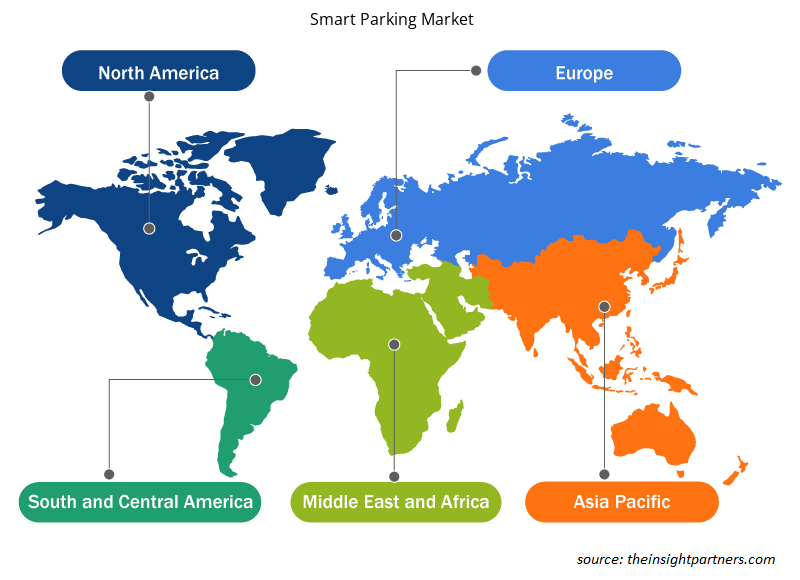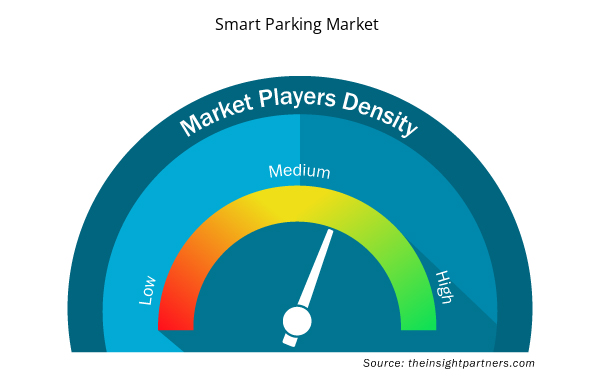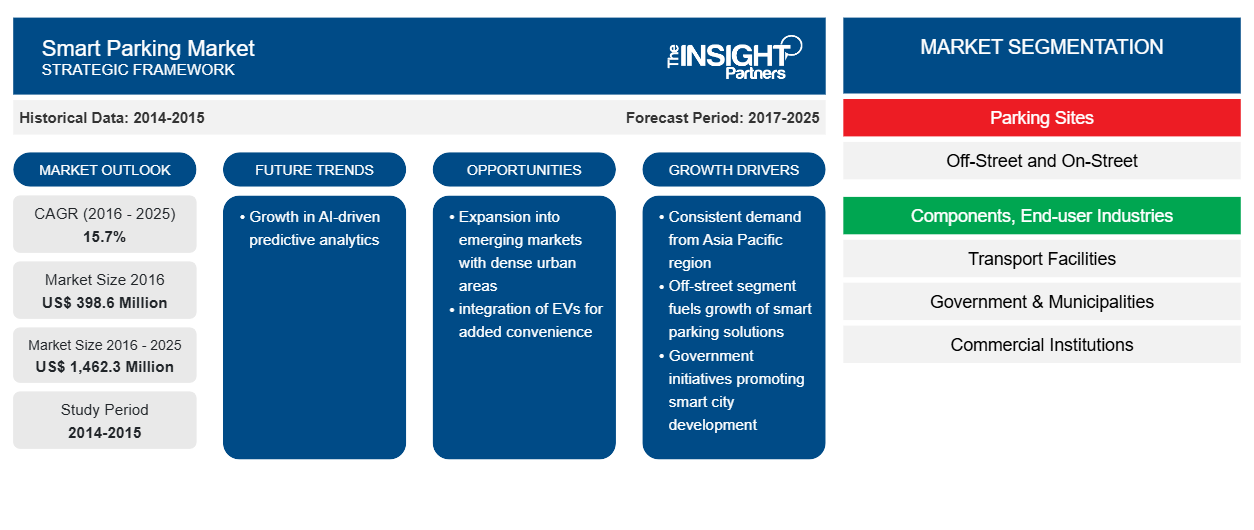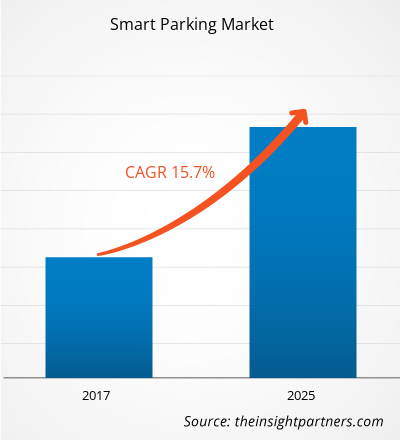Le marché du stationnement intelligent devrait passer de 398,6 millions USD en 2016 à 1 462,3 millions USD d'ici 2025, à un TCAC de 15,7 % entre 2017 et 2025.CAGR of 15.7% between 2017 and 2025.
Les systèmes de stationnement intelligents répondent aux problèmes critiques de stationnement, en permettant aux conducteurs de garer plus facilement leurs véhicules sans perdre de temps et de carburant. Les systèmes de stationnement intelligents fournissent à leurs utilisateurs des informations en temps réel sur les places de stationnement disponibles dans la ville, réduisant ainsi les embouteillages causés par des places de stationnement mal gérées. Amano Mcgann, Smart Parking Ltd., Xerox, Cisco et Urbiotica figurent parmi les principaux acteurs opérant sur ce marché. L'Amérique du Nord, étant une région technologiquement avancée avec un nombre élevé de véhicules et de congestion dans les villes, a connu le plus grand nombre d'adoptions de systèmes de stationnement intelligents par les gouvernements et les municipalités de diverses villes. L'Europe est le deuxième plus grand adoptant de systèmes de stationnement intelligent, tandis que la région APAC, avec une urbanisation croissante et des tendances technologiques croissantes, devrait être la région à la croissance la plus rapide au monde sur le marché du stationnement intelligent
Informations sur le marché
Le marché du stationnement intelligent stimulé par la croissance continue de la demande en Asie-Pacifique
Actuellement, les systèmes de stationnement intelligents connaissent une adoption significative dans les pays d'Amérique du Nord et d'Europe. De plus, grâce aux progrès de la technologie et des infrastructures, dans diverses économies en développement de l'APAC et du MEA, notamment le grand projet de la ville de Wellington, les projets pilotes à Canberra, Singapour, la Thaïlande, Dubaï et l'Arabie saoudite devraient connaître une adoption significative des solutions de stationnement intelligent. Bien que l'Amérique du Nord et l'Europe dominent le marché mondial du stationnement intelligent, elles devraient perdre leur part de revenus au profit de l'Asie-Pacifique au cours de la période de prévision. En revanche, l'APAC devrait enregistrer un taux de croissance de 18,9 % entre 2016 et 2025 sur le marché mondial du stationnement intelligent.
Personnalisez ce rapport en fonction de vos besoins
Vous bénéficierez d'une personnalisation gratuite de n'importe quel rapport, y compris de certaines parties de ce rapport, d'une analyse au niveau des pays, d'un pack de données Excel, ainsi que de superbes offres et réductions pour les start-ups et les universités.
- Obtenez les principales tendances clés du marché de ce rapport.Cet échantillon GRATUIT comprendra une analyse de données, allant des tendances du marché aux estimations et prévisions.
Le marché mondial du stationnement intelligent est propulsé par le segment du stationnement hors rue
Technological advancements such as use of mobile applications for parking guidance systems, enhanced ticketing and payment solutions and significant growth in adoption of smart parking systems by commercial and corporate institutions are the factors expected to boost the demand for off-street parking management system market. This type of parking is beneficial to both short as well as long term parking users. However, high initial deployment cost of off-street parking systems is expected to restrict the growth of the market. The off-street parking segment leads the global smart parking market currently and is expected to continue its dominance during the forecast period.
Market initiative was observed as the most adopted strategy in global smart parking market. Few of the recent strategies by some of the players in smart parking market landscape are listed below
- 2017: Amano Mcgann extended its partnership with one of its oldest dealers PSX to Colorado.
- 2017: Valeo and Cisco announced a cooperation agreement to develop strategic innovations in smart mobility services.
- 2017: Smart Parking announced that it won a new contract in New Zealand, chosen by Wilson Parking New Zealand as the preferred supplier of sensor and bay-finding technology at nine new sites.
- 2017: Smart Parking launched its newly designed SmartSpot IoT Gateway, with new and improved features adapted to meet the needs of smart city
Smart Parking Market Regional Insights
The regional trends and factors influencing the Smart Parking Market throughout the forecast period have been thoroughly explained by the analysts at Insight Partners. This section also discusses Smart Parking Market segments and geography across North America, Europe, Asia Pacific, Middle East and Africa, and South and Central America.

- Get the Regional Specific Data for Smart Parking Market
Smart Parking Market Report Scope
| Report Attribute | Details |
|---|---|
| Market size in 2016 | US$ 398.6 Million |
| Market Size by 2025 | US$ 1,462.3 Million |
| Global CAGR (2016 - 2025) | 15.7% |
| Historical Data | 2014-2015 |
| Forecast period | 2017-2025 |
| Segments Covered | By Parking Sites
|
| Regions and Countries Covered | North America
|
| Market leaders and key company profiles |
|
Market Players Density: Understanding Its Impact on Business Dynamics
Le marché du stationnement intelligent connaît une croissance rapide, tirée par la demande croissante des utilisateurs finaux en raison de facteurs tels que l'évolution des préférences des consommateurs, les avancées technologiques et une plus grande sensibilisation aux avantages du produit. À mesure que la demande augmente, les entreprises élargissent leurs offres, innovent pour répondre aux besoins des consommateurs et capitalisent sur les tendances émergentes, ce qui alimente davantage la croissance du marché.
La densité des acteurs du marché fait référence à la répartition des entreprises ou des sociétés opérant sur un marché ou un secteur particulier. Elle indique le nombre de concurrents (acteurs du marché) présents sur un marché donné par rapport à sa taille ou à sa valeur marchande totale.
Les principales entreprises opérant sur le marché du stationnement intelligent sont :
- Amano McGann, Inc.
- Cisco
- Parking intelligent Ltée.
- Urbiotica
- SKIDATA AG
Avis de non-responsabilité : les sociétés répertoriées ci-dessus ne sont pas classées dans un ordre particulier.

- Obtenez un aperçu des principaux acteurs du marché du stationnement intelligent
Systèmes de stationnement intelligents mondiaux – Segmentation du marché
Par parking
- Stationnement hors rue
- Stationnement dans la rue
Par composants
- Matériel
- Logiciel
- Service
Par secteur d'activité de l'utilisateur final
- Moyens de transport
- Gouvernements et municipalités
- Institutions commerciales
- Institutions corporatives
Par géographie
- Amérique du Nord
- NOUS
- Canada
- Mexique
- Europe
- France
- Allemagne
- Italie
- Espagne
- ROYAUME-UNI
- Reste de l'Europe
- Asie-Pacifique (APAC)
- Japon
- Chine
- Inde
- Australie
- Reste de l'APAC
- Moyen-Orient et Afrique (MEA)
- Arabie Saoudite
- Émirats arabes unis
- Afrique du Sud
- Reste de la MEA
- Amérique du Sud (SAM)
- Brésil
- Reste de SAM
Profils d'entreprise
- Cisco Systems, Inc.
- Amano McGann, Inc.
- Parking intelligent Ltée.
- Urbiotica
- Skidata SA
- Swarco SA
- Parkmobile, LLC
- Nedap S.A.
- Kapsch
- Xerox Corp.
- Parkmobile, LLC
- SWARCO AG
- Analyse historique (2 ans), année de base, prévision (7 ans) avec TCAC
- Analyse PEST et SWO
- Taille du marché Valeur / Volume - Mondial, Régional, Pays
- Industrie et paysage concurrentiel
- Ensemble de données Excel



Report Coverage
Revenue forecast, Company Analysis, Industry landscape, Growth factors, and Trends

Segment Covered
This text is related
to segments covered.

Regional Scope
North America, Europe, Asia Pacific, Middle East & Africa, South & Central America

Country Scope
This text is related
to country scope.
Trends and growth analysis reports related to Electronics and Semiconductor : READ MORE..
The List of companies - Smart Parking Market
- Amano McGann, Inc.
- Cisco
- Smart Parking Ltd.
- Urbiotica
- SKIDATA AG
- Nedap NV
- Kapsch
- Xerox Corp.
- Parkmobile, LLC
- SWARCO AG
The Insight Partners performs research in 4 major stages: Data Collection & Secondary Research, Primary Research, Data Analysis and Data Triangulation & Final Review.
- Data Collection and Secondary Research:
As a market research and consulting firm operating from a decade, we have published and advised several client across the globe. First step for any study will start with an assessment of currently available data and insights from existing reports. Further, historical and current market information is collected from Investor Presentations, Annual Reports, SEC Filings, etc., and other information related to company’s performance and market positioning are gathered from Paid Databases (Factiva, Hoovers, and Reuters) and various other publications available in public domain.
Several associations trade associates, technical forums, institutes, societies and organization are accessed to gain technical as well as market related insights through their publications such as research papers, blogs and press releases related to the studies are referred to get cues about the market. Further, white papers, journals, magazines, and other news articles published in last 3 years are scrutinized and analyzed to understand the current market trends.
- Primary Research:
The primarily interview analysis comprise of data obtained from industry participants interview and answers to survey questions gathered by in-house primary team.
For primary research, interviews are conducted with industry experts/CEOs/Marketing Managers/VPs/Subject Matter Experts from both demand and supply side to get a 360-degree view of the market. The primary team conducts several interviews based on the complexity of the markets to understand the various market trends and dynamics which makes research more credible and precise.
A typical research interview fulfils the following functions:
- Provides first-hand information on the market size, market trends, growth trends, competitive landscape, and outlook
- Validates and strengthens in-house secondary research findings
- Develops the analysis team’s expertise and market understanding
Primary research involves email interactions and telephone interviews for each market, category, segment, and sub-segment across geographies. The participants who typically take part in such a process include, but are not limited to:
- Industry participants: VPs, business development managers, market intelligence managers and national sales managers
- Outside experts: Valuation experts, research analysts and key opinion leaders specializing in the electronics and semiconductor industry.
Below is the breakup of our primary respondents by company, designation, and region:

Once we receive the confirmation from primary research sources or primary respondents, we finalize the base year market estimation and forecast the data as per the macroeconomic and microeconomic factors assessed during data collection.
- Data Analysis:
Once data is validated through both secondary as well as primary respondents, we finalize the market estimations by hypothesis formulation and factor analysis at regional and country level.
- Macro-Economic Factor Analysis:
We analyse macroeconomic indicators such the gross domestic product (GDP), increase in the demand for goods and services across industries, technological advancement, regional economic growth, governmental policies, the influence of COVID-19, PEST analysis, and other aspects. This analysis aids in setting benchmarks for various nations/regions and approximating market splits. Additionally, the general trend of the aforementioned components aid in determining the market's development possibilities.
- Country Level Data:
Various factors that are especially aligned to the country are taken into account to determine the market size for a certain area and country, including the presence of vendors, such as headquarters and offices, the country's GDP, demand patterns, and industry growth. To comprehend the market dynamics for the nation, a number of growth variables, inhibitors, application areas, and current market trends are researched. The aforementioned elements aid in determining the country's overall market's growth potential.
- Company Profile:
The “Table of Contents” is formulated by listing and analyzing more than 25 - 30 companies operating in the market ecosystem across geographies. However, we profile only 10 companies as a standard practice in our syndicate reports. These 10 companies comprise leading, emerging, and regional players. Nonetheless, our analysis is not restricted to the 10 listed companies, we also analyze other companies present in the market to develop a holistic view and understand the prevailing trends. The “Company Profiles” section in the report covers key facts, business description, products & services, financial information, SWOT analysis, and key developments. The financial information presented is extracted from the annual reports and official documents of the publicly listed companies. Upon collecting the information for the sections of respective companies, we verify them via various primary sources and then compile the data in respective company profiles. The company level information helps us in deriving the base number as well as in forecasting the market size.
- Developing Base Number:
Aggregation of sales statistics (2020-2022) and macro-economic factor, and other secondary and primary research insights are utilized to arrive at base number and related market shares for 2022. The data gaps are identified in this step and relevant market data is analyzed, collected from paid primary interviews or databases. On finalizing the base year market size, forecasts are developed on the basis of macro-economic, industry and market growth factors and company level analysis.
- Data Triangulation and Final Review:
The market findings and base year market size calculations are validated from supply as well as demand side. Demand side validations are based on macro-economic factor analysis and benchmarks for respective regions and countries. In case of supply side validations, revenues of major companies are estimated (in case not available) based on industry benchmark, approximate number of employees, product portfolio, and primary interviews revenues are gathered. Further revenue from target product/service segment is assessed to avoid overshooting of market statistics. In case of heavy deviations between supply and demand side values, all thes steps are repeated to achieve synchronization.
We follow an iterative model, wherein we share our research findings with Subject Matter Experts (SME’s) and Key Opinion Leaders (KOLs) until consensus view of the market is not formulated – this model negates any drastic deviation in the opinions of experts. Only validated and universally acceptable research findings are quoted in our reports.
We have important check points that we use to validate our research findings – which we call – data triangulation, where we validate the information, we generate from secondary sources with primary interviews and then we re-validate with our internal data bases and Subject matter experts. This comprehensive model enables us to deliver high quality, reliable data in shortest possible time.


 Obtenez un échantillon gratuit pour ce rapport
Obtenez un échantillon gratuit pour ce rapport